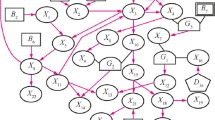Abstract
In this paper we evaluate and extend existing methods for an intended application for monitoring and diagnosis of a combined heat-power system. Only a few methods in model based diagnosis take advantage of the available design model by using (semi-)qualitative abstractions of ordinary differential equations, e.g. by Dvorak and Kuipers (1989), Ng (1990) and Lackinger and Nejdl (1991). Diagnosis of complex devices benefits from hierarchical models, both from a modelling perspective and from a computational perspective. This leads us to prefer the hierarchical diagnosis methoddiamon (Lackinger and Nejdl, 1991). We propose an extension of diamon, calleddyana, that is suitable for on-line diagnosis and uses an alternative method for dynamic model zooming which is based on heuristics regarding parsimony of diagnoses and consistency of fault models.dyana also uses numerical simulation, based on differential equations, instead of qualitative simulation.
Similar content being viewed by others
References
P. Dague, O. Jehl, P. Devès, P. Luciani and P. Taillibert, When oscillators stop oscillating, in:Proc. 12th IJCAI, Sydney, 1991, pp. 1109–1115.
R. Davis, Diagnostic reasoning based on structure and behavior, Artificial Intelligence 24 (1984) 347–410.
J. de Kleer and B.C. Williams, Diagnosing multiple faults, Artificial Intelligence 32 (1987) 97–130.
J. de Kleer and B.C. Williams, Diagnosis with behavioral modes, in:Proc 11th. IJCAI, Detroit, 1989, pp. 1324–1330.
D. Dvorak and B. Kuipers, Model-based monitoring of dynamic systems, in:Proc. Int. Joint Conference on Artificial Intelligence (IJCAI), Detroit, 1989 (Morgan Kaufmann) pp. 1238–1243.
D. Dvorak and B. Kuipers, Proces monitoring and diagnosis, IEEE Expert (June 1991) pp. 67–73.
R. Greiner, B.A. Smith and R.W. Wilkerson, A correction to the algorithm in Reiter's theory of diagnosis, Artificial Intelligence 41 (1989) 79–88.
W. Hamscher, Modelling digital circuits for troubleshooting, Artificial Intelligence 51 (1991) 223–271.
D.C. Karnopp, D.L. Margolis and R.C. Rosenberg,System Dynamics: A Unified Approach (Wiley, New York, 1990) Second Revised Ed.
B. Kuipers, Qualitative simulation, Artificial Intelligence 29 (1986) 289–388.
F. Lackinger and W. Nejdl, Integrating model-based monitoring and diagnosis of complex dynamic systems, in:Proc. 12th IJCAI, Sydney, 1991, pp. 1123–1128.
H.T. Ng, Model-based multiple fault diagnosis of time-varying continuous physical devices, in:Proc. IEEE Conf. on Artificial Intelligence Applications, 1990.
R. Patton, P. Frank and R. Clark (eds.),Fault Diagnosis in Dynamic Systems: Theory and Applications, Int. Series in Systems and Control Engineering (Prentice Hall, 1989).
M. Reinders and B. Bredeweg, Reflective strategic control of multiple problem solving methods, in: ed. B. Neumann,Proc. 10th European Conf. on AI (ECAI'92), Vienna, 1992, pp. 577–581.
M. Reinders and A. Pos, Dyana, An application of methods for diagnosis for continuous dynamic systems, in:Working Notes ECAI'92 Workshop on Model Based Reasoning, Vienna, 1992, pp. 83–91.
M. Reinders, E. Vinkhuyzen, A. Voss, J. M. Akkermans, J. R. Balder, B. Bartsch-Spörl, B. Bredeweg, U. Drouven, F. van Harmelen, W. Karbach, Z. Karssen, A. Th. Schreiber and B. J. Wielinga, A conceptual modelling framework for knowledge-level reflection, AI Communications 4(2–3) (1991) 74–87.
R. Reiter, A theory of diagnosis from first principles, Artificial Intelligence 32 (1987) 57–96.
P. Struss and O. Dressler, Physical negation — integrating fault models into the general diagnostic engine, in:Proc 11th IJCAI, Detroit, 1989, pp. 1318–1323.
J. L. Top and J. M. Akkermans, Computational and physical causality, in:Proc. IJCAI-91, Sydney, 1991 (Morgan Kaufmann) pp. 1171–1176.
Author information
Authors and Affiliations
Additional information
This article is dedicated to the memory of Martin Reinders. During the preparation of this paper, Martin died in an air accident. Please send any correspondence concerning this article to Hans Akkermans, at the above address (E-mail: akkermans@ecn.nl or akkerman@cs.utwente.nl).
Rights and permissions
About this article
Cite this article
Reinders, M., Pos, A. & van der Neut, F. DYANA: Best-first hierarchical diagnosis based on differential equation models. Ann Math Artif Intell 11, 315–328 (1994). https://doi.org/10.1007/BF01530748
Issue Date:
DOI: https://doi.org/10.1007/BF01530748




